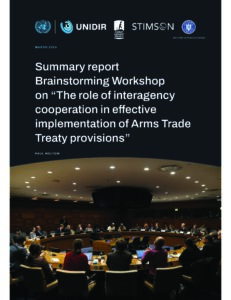Introduction
The Arms Trade Treaty (ATT) is the only legally binding instrument to regulate the global arms trade. At its core, the ATT aims to promote transparency in the arms trade in order to build confidence amongst States Parties. One way that the treaty advances this objective is its requirement for States Parties to annually report on their arms exports and imports.
This report examines the 2019 ATT annual reports submitted to the ATT Secretariat by 5 October 2020, and highlights information provided by ATT States Parties on their arms exports and imports that occurred during the 2019 calendar year. In analyzing the 2019 ATT annual reports, this report reflects on the fifth year of reporting on annual arms exports and imports to the ATT, highlights emerging trends in reporting practices, and identifies certain challenges to transparency.
| Article 13 – Reporting 1. Each State Party shall, within the first year after entry into force of this Treaty for that State Party, in accordance with Article 22, provide an initial report to the Secretariat of measures undertaken in order to implement this Treaty, including national laws, national control lists and other regulations and administrative measures. Each State Party shall report to the Secretariat on any new measures undertaken in order to implement this Treaty, when appropriate. Reports shall be made available, and distributed to States Parties by the Secretariat. 2. States Parties are encouraged to report to other States Parties, through the Secretariat, information on measures taken that have been proven effective in addressing the diversion of transferred conventional arms covered under Article 2 (1). 3. Each State Party shall submit annually to the Secretariat by 31 May a report for the preceding calendar year concerning authorized or actual exports and imports of conventional arms covered under Article 2 (1). Reports shall be made available, and distributed to States Parties by the Secretariat. The report submitted to the Secretariat may contain the same information submitted by the State Party to relevant United Nations frameworks, including the United Nations Register of Conventional Arms. Reports may exclude commercially sensitive or national security information. |
Methodology
Information analyzed throughout this report is derived from the 53 annual reports provided on the ATT Secretariat’s website as of 5 October 2020. Comparative information on ATT States Parties’ 2019 arms exports and imports is also derived from submissions to the UN Register of Conventional Arms (UNROCA) for calendar year 2019 imports and exports. Additionally, this report includes information provided by the ATT Secretariat to help clarify States Parties’ submissions and offer insights on reporting obligations and compliance.
This report is divided into four sections. Section one reviews the status of reporting for the 2019 ATT annual reports and provides a comparison with previous years. Section two examines reporting practices and highlights trends in how States Parties are reporting on their arms exports and imports. Section three compares the 2019 ATT annual reports with reports submitted to UNROCA and identifies broader transparency trends and challenges. The report concludes with some preliminary observations on trends in reporting over the last five years and offers insights for improving ATT annual reports to advance the promise of the ATT in increasing transparency in the arms trade.




